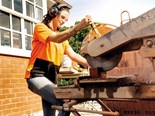Profile: Katana Foundations NZ
 Roger Balzer (left) and Shane Campbell
Roger Balzer (left) and Shane Campbell

 The screw piles have been designed for quick installation
The screw piles have been designed for quick installation

 Screw piers in action
Screw piers in action

 With screw piers, there is no mess from drilling
With screw piers, there is no mess from drilling

 The screw piers by Katana have been designed for New Zealand conditions
The screw piers by Katana have been designed for New Zealand conditions


|
|
Roger Balzer (left) and Shane Campbell
|

|
|
The screw piles have been designed for quick installation
|

|
|
Screw piers in action
|

|
|
With screw piers, there is no mess from drilling
|

|
|
The screw piers by Katana have been designed for New Zealand conditions
|
Katana Foundations NZ has hit the mark on durability with it's new Auger Torque Earth Drill 10,000 unit and Hyundai RC55-9 digger combination
In a somewhat non-descript building and a stone’s throw from the motorway, on the southern edge of Auckland, is where you’ll find Katana Foundations NZ—a screw piling business set up by two families, who are providing innovative techniques to the way buildings begin life.

Screw piers (also known as piles), for those not in the know, are essentially oversized Helical screws that are drilled into the ground, providing a secure foundation from which a building can grow from.
Shane Campbell, company project manager, says that through local soil testing and support from Katana Australia and STA Engineers, they’ve designed new products especially suited for New Zealand conditions.
"These drill directly into the ground and are suitable for both concrete and timber
sub-floored buildings," he says.
Timber poles vs. screw piles
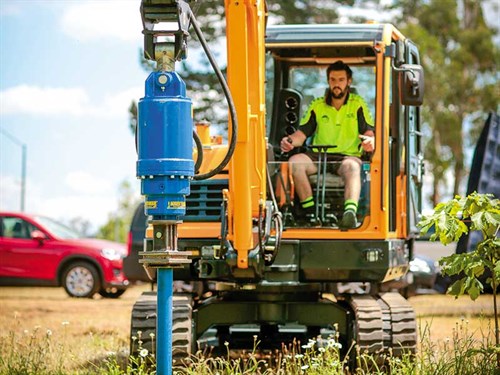
Unlike timber pole foundations, a screw pile creates little ground disturbance and the operation requires no spoil to be removed from the site.
"Contaminated or soft spoil doesn’t need to be moved, and in the case of Auckland, can mean a cost saving of $450 to $650 per truck load.
"There is no mess from drilling, no concrete to hold them in place, and no emptying out holes filled with water when it rains," Shane says.
Time is another factor, with screw piles beating timber poles by a substantial margin. Shane tells us that work for a house can usually be completed within a day.
Another bonus is screw piles can be placed closer to underground services, as ground disturbance is minimal.
"With water and trunk lines, most buildings have to stay five metres away when they’re punching regular piles in, but with screw piers we can usually get to 1.5 [metres], which means you can probably get more houses on the property," Katana national manager, Roger Balzer, says.
Katana's turn to screw piles
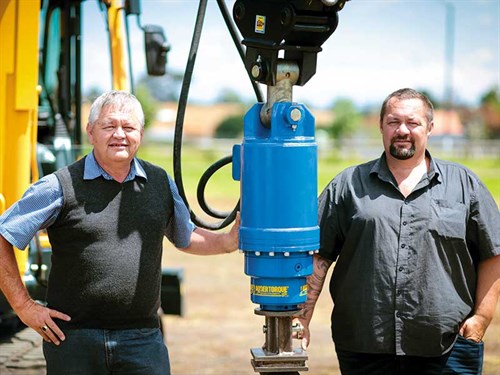
Katana’s beginnings were formed when a job Roger and Shane were working on in Mangere, South Auckland encountered difficulties.
"We were working on sewer pipes five metres down and trying to dig a hole out, then put a cage in, so we could install timber poles, which was a big negative expense," Roger says.
Not satisfied with the efficiency of the job and convinced screw piles were the answer, investigations found a supplier in the country, who sourced them out of the US.
"They were good gear but hugely expensive," Roger says. Australian design Intent on finding a cost-effective solution, Roger and Shane’s search eventually led them to Australia.
"We were doing steel fabrication then and an associate we were talking to led us to an Australian company that designed screw piles and it just grew from that, with us obtaining the rights to the New Zealand and South Pacific regions," Roger says.
However, it wasn’t a matter of ordering in a few container loads of screw piles and getting to work though, as New Zealand ground conditions differ substantially to those over the ditch.
"Their [ground] issues in Australia are totally different to ours. When they came here to work out what
was going to be our original stockpile of gear, they found our soils are like mud," Roger says.
Not one to walk away from a challenge, the design engineers then constructed models to get optimal strength for New Zealand conditions.
Portable building foundations
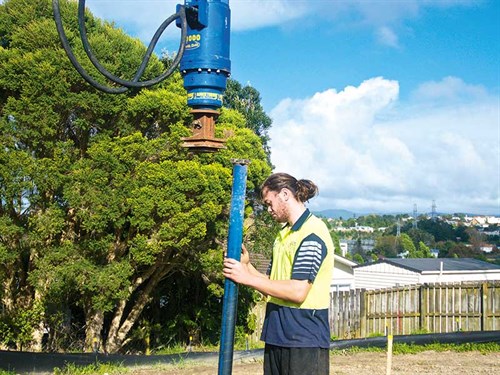
The company has also come up with a solution for portable buildings, with screw piles designed for quick installation and one model that can accommodate trailerised buildings. This system enables everything to be pre-drilled and then taken out once a building has been removed from the site.
"No spoil off-site, no concrete, no pump, no inspection, and the option of removing the piles once the building has been removed," Shane says.
Piling machinery
However, all this would be naught if it wasn’t for the equipment to get the screw piles into the earth. In Katana’s case, they elected to follow the lead of their Australian counterparts and use Auger Torque drill heads and Hyundai machinery to provide the diesel power.
"We didn’t see any benefit in trying to reinvent the wheel," Shane says.
"In Australia, they’ve been using this combination for some time and it made more sense for us to follow their lead."
Shane goes on to say the power the Hyundai RC55-9 and Auger Torque Earth Drill 10,000 drill head provide is more than adequate when sinking screw piles, usually around three metres into the ground.
Dual hydraulic flow
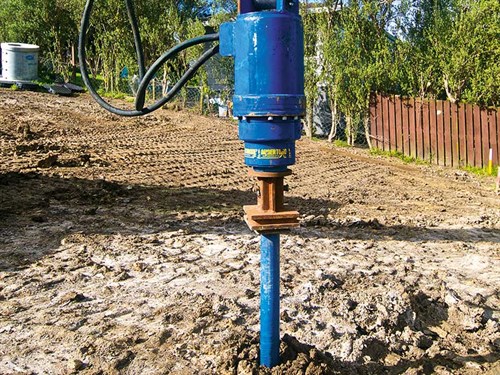
The excavator is especially set up to provide dual hydraulic flow when required, or four-wheel drive, as Shane describes it; this being used to drive the screw piles further into the ground.
"Sometimes we have to go deeper or not as deep. It all depends on the conditions of the ground," he says. "The drill head is overspecced for standardised stuff, but with screw piles, you need that torque."
However, ground conditions are not guessed when screw piles are placed. The machine combo is set up with a gauge that gives an accurate measurement of when the correct pressure is being exerted on the screw pile. If the correct pressure hasn’t been reached, then extensions are added until the gauge hits the right mark, between 1200 and 1500psi.
"This enables us to provide engineers with data readings for their calculations and you can’t get that with a timber pile. There’s no guesswork here. Everything we place is exact and there are no building inspections at all, as we do the lot," Shane says.
"We come in one day, do the install, and sign off, and then the next day, the builders can start with the sub-floor. It’s a 60% time-saving, and we can even pier in the rain."
The future plans for Katana
Currently, the business is set up for the North Island, with a plan for the next 12 months to expand into the South Island. Shane says, if suitable work presented itself sooner then, Katana would reassess the time frame.
Even though it’s only been around 12 months since the business was established, Roger says they will soon be looking at adding additional equipment.
Keep up to date in the industry by signing up to Deals on Wheels' free newsletter or liking us on Facebook.








